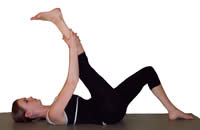Flexibility

As promised I am returning to the subject of stretching. Post-exercise stretching contributes to the greatest gains in over all flexibility. The key to optimal stretching is performing the stretches on warm, blood-filled muscles. There are many types of stretching, from PNF, assisted stretching, passive stretching and through yoga positions. These stretches are held statically for approximately 30 seconds, and then repeated two or three times. When performing the stretches it is necessary to go to the point of tension, ease up just a bit and then hold the position. With each repetition, tension should lessen and range of motion should increase if only a minute amount. It is important to apply pressure to the muscle body and not the joint area. It helps to understand the position and action of each muscle in order to stretch it properly. Be careful not to over stretch the muscles or quickly stretch them as there is a protective reflex which will cause the muscle to quickly contract or shorten, which is potentially a cause for injury and contrary to the goal. Stretching should be done after every workout for maximum benefits. Some believe that by allowing the lactic acid to dissipate throughout the muscle, soreness after exercise is reduced. Whether or not it affects delayed onset of soreness is debatable but most will agree that stretching just plain feels good! A flexible body moves with a more youthful appearance and definitely improves the quality of life.
In future posts I will explain in greater detail assisted stretching and PNF stretching. I also will address the musculature of the trunk as it pertains to stretch vs. strength and the functionality of trunk stability. From the vantage point of a trainer, corrective stretches are where it all begins.
So to review, muscles should be warm, stretches should be static, and flexibility should be a component of every workout.